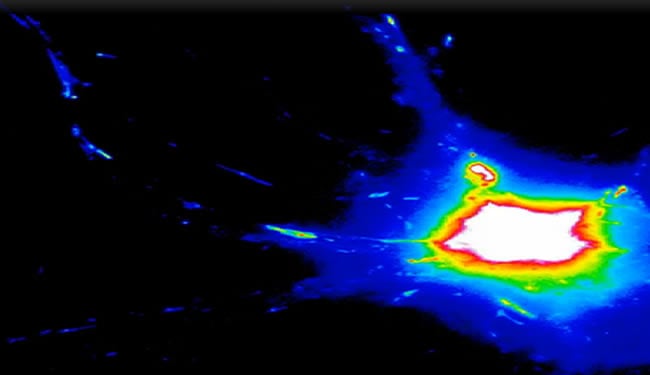New imaging technique reveals the brain’s continuous renovation.
Using bioluminescent proteins from a jellyfish, a team of scientists has lit up the inside of a neuron, capturing spectacular video footage that shows the movement of proteins throughout the cell.
The video offers a rare peek at how proteins, the brain’s building blocks, are directed through neurons to renew its structure.
“Your brain is being disassembled and reassembled every day,” said Don Arnold, associate professor of molecular and computational biology at the USC Dornsife College of Letters, Arts and Sciences, and corresponding author of an article about the research that appeared in Cell Reports on July 26.
“One week from today, your brain will be made up of completely different proteins than it is today,” Arnold said. “This video shows the process. We’ve known that it was happening, but now we can watch it happen.”
Video depicting the flow of transport vesicles containing NgCAM, an axonal protein. (Courtesy of Don Arnold and Sarmad Al-Bassam) From USC user on Youbtube.com
The new imaging technique was used to cast new light on how proteins are directed to one of the two types of compartments inside the neuron: the axon or the dendrites.
The axon is the region of the cell responsible for transmitting electrical signals to other cells, while the dendrites receive signals from other cells.
“It’s been known for many decades that proteins are specifically targeted to one compartment or the other. However, we couldn’t understand how the targeting occurs until we could actually watch the proteins traveling to one compartment or to the other,” said Sarmad Al-Bassam, USC Ph.D. student and lead author of the Cell Reports article.
Since the mid-1990s, scientists have been able to illuminate the proteins inside of cells, including neurons, by attaching a protein isolated from jellyfish—known as GFP (green fluorescent protein)—that fluoresces bright green when exposed to blue light.
Martin Chalfie of Columbia University, Roger Tsien of the University of California-San Diego, and Osamu Shimomura of Boston University were awarded the Nobel Prize in Chemistry in 2008 for the discovery and development of GFP.
The problem with studying the flow of illuminated proteins inside of neurons is that there are several different overlapping pathways within the cell, making it difficult to study the traffic through just one.
Al-Bassam and his colleagues solved this issue by developing a new technique that involves damming up a single pathway, which creates a backlog of transport vesicles (little bubbles that travel up and down neurons carrying membrane protein cargo) impregnated with the illuminated proteins. They then use a small-molecule drug to release the backlog all at once in a bright pulse.
The same video as above, using a 16-color filter. Video depicting the flow of transport vesicles containing NgCAM, using a 16-color filter. Here, the intensity of the pixels (and thus protein concentration) varies from white (very high) to purple (very low). (Courtesy of Don Arnold and Sarmad Al-Bassam)
“Our result was very surprising,” said Don Arnold, associate professor of molecular and computational biology at the USC Dornsife College of Letters, Arts and Sciences and corresponding author of the Cell Reports article. “We found that rather than being targeted specifically to the dendrites, vesicles carrying proteins initially enter both compartments, but then are stopped and prevented from moving beyond the initial segment of the axon.”

Notes about this brain research
Al-Bassam and Arnold worked with USC postdoctoral fellow Min Xu as well as Thomas J. Wandless, professor at Stanford University.
This research was funded by National Institutes of Health grants NS-041963 and MH-086381.
Contact: Robert Perkins – USC
Source: University of Southern California press release
Image Source: Neuron image taken from Youtube.com video from user USC.
Video Sources: Neuroscience videos (1, 2) were shared on Youtube.com by the user USC
Original Research: Full access to research paper for “Differential Trafficking of Transport Vesicles Contributes to the Localization of Dendritic Proteins” by Sarmad Al-Bassam, Min Xu, Thomas J. Wandless and Don B. Arnold in Cell Reports 5 July 2012 Volume 2, Issue 1, 89-100 doi: 10.1016/j.celrep.2012.05.018







